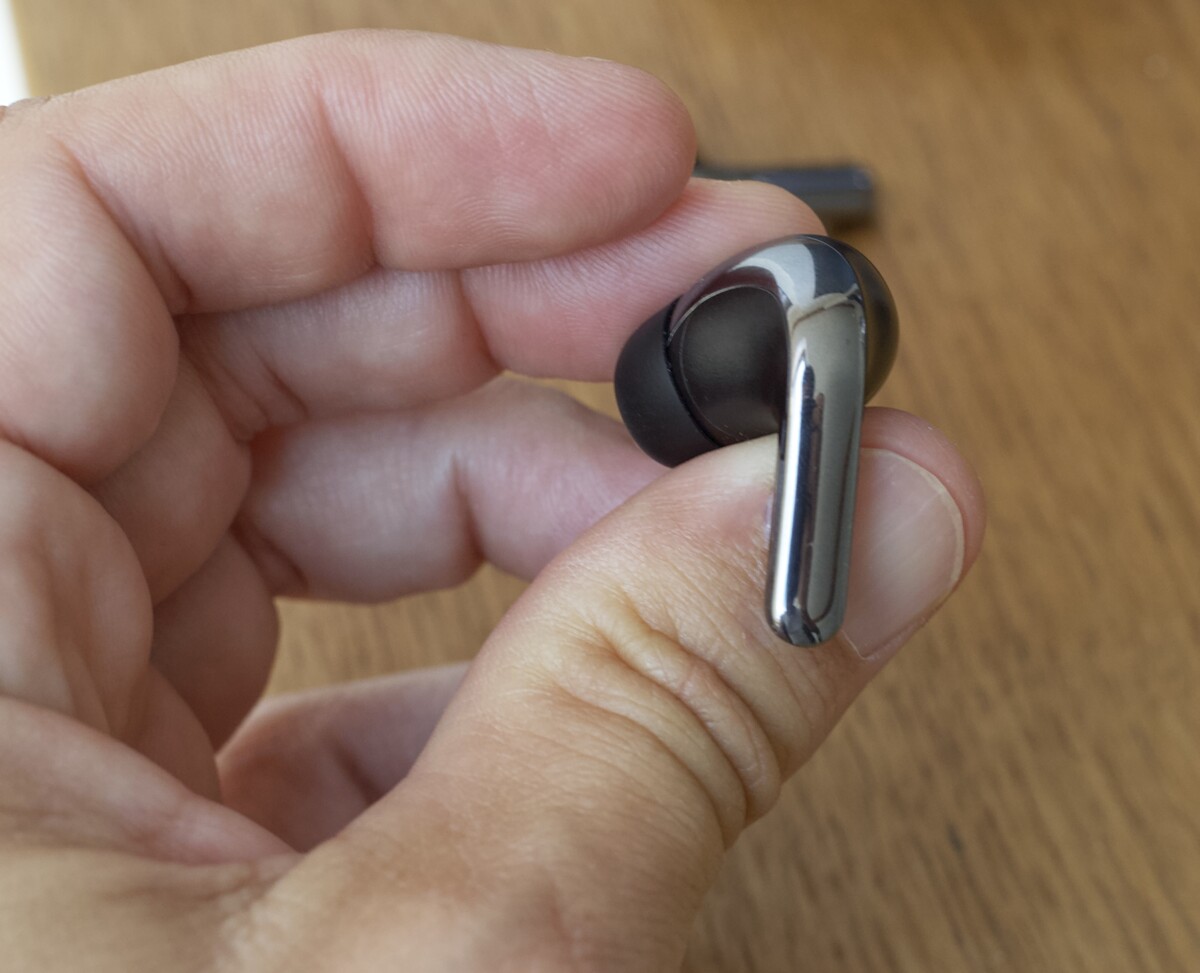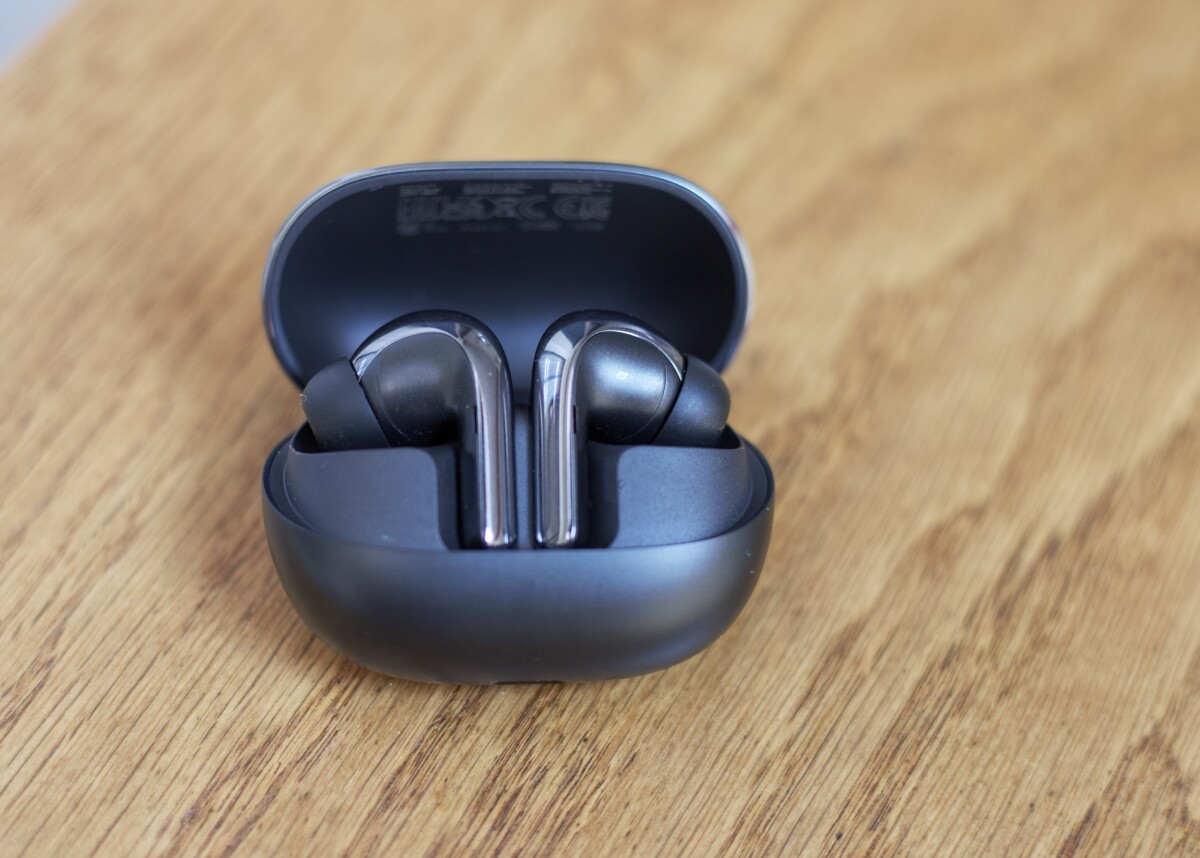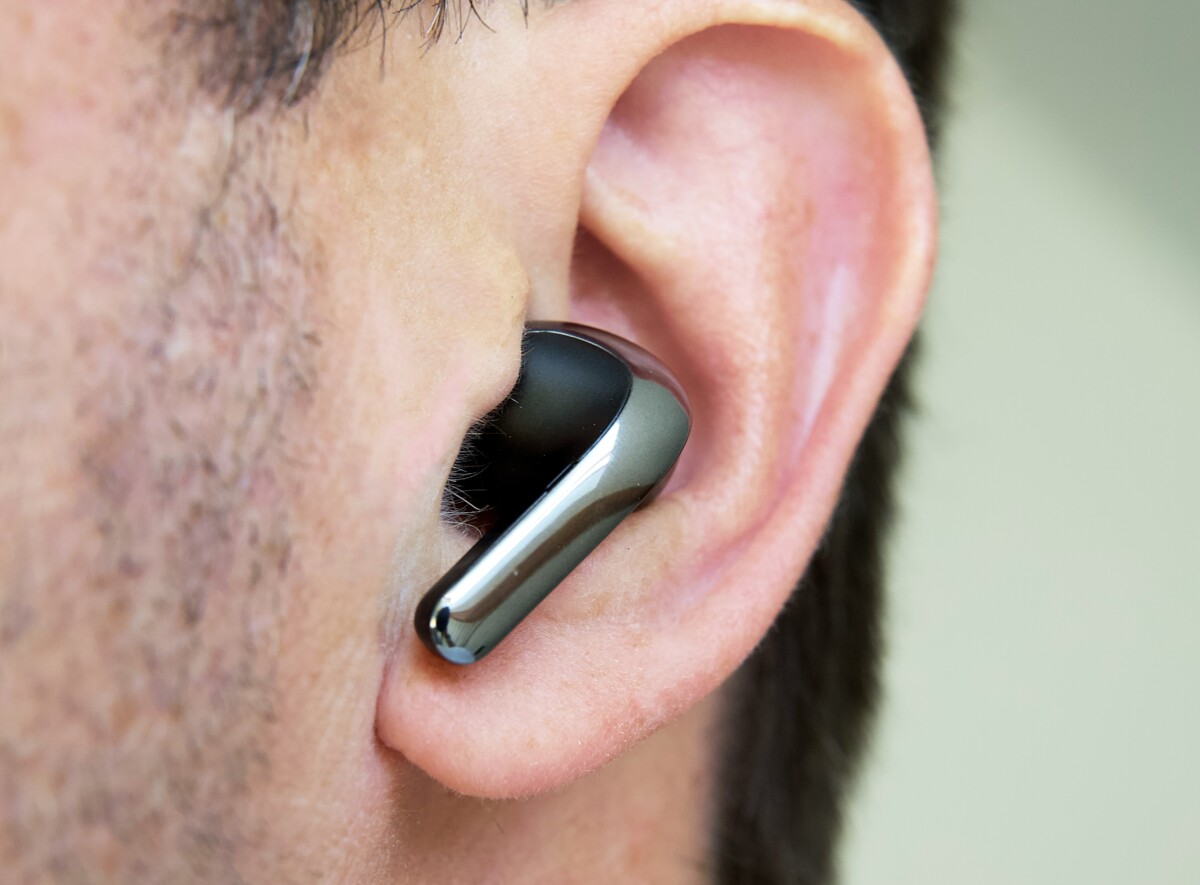After the Redmi Buds 4 Pro, which belong to Xiaomi’s budget range, the company now offers the Buds 4 Pro with equally enticing technical specifications. Just look at what they have to offer: Hi-Res Audio, “dual balanced armature” transducers, immersive Spatial Audio, up to 48 dB of active noise cancellation, high-quality calls, and stellar battery life with fast charging. Even the price is premium, at $249 USD, higher than the excellent Sony WF-1000XM4 and not far from the exceptional Apple AirPods Pro 2. But is it too good to be true?
Xiaomi Buds 4 Pro Design
The Xiaomi Buds 4 Pro are compact in-ear headphones that bear a clear resemblance to the Apple AirPods Pro 2. While the two differ in their bimaterial design of matte black plastic and glossy silver, the concept remains the same—a rounded shell that fits snugly in the ear, extended by a stem with clickable control buttons. The build quality is excellent, especially regarding the multiple microphone grilles and the active noise cancellation system.

These earphones are easy to fit in the ear without requiring any particular rotation. They offer excellent stability and comfort, allowing for long listening sessions. The manufacturer provides two additional sets of ear tips.

One minor disappointment is the large lid of the charging case, which makes it slightly cumbersome to handle. Additionally, the lid hinges seem fragile. However, storing the earphones in the case requires minimal effort. Charging can be done via USB-C or with a Qi wireless charger (not included).
Xiaomi Buds 4 Pro Usage and Application
The touch controls of the Xiaomi Buds 4 Pro resemble those of the AirPods Pro 2, with a small clickable area on each earphone that emits a mechanical click sound for confirmation. However, unlike Apple’s earphones, there is no touch-sensitive area for adjusting the volume on the Buds 4 Pro by default. To do so, you need to use the Xiaomi Earbuds app and reprogram the buttons. However, in any case, it is impossible to have volume control, track change, active noise cancellation, and voice assistant invocation functions simultaneously.
A Dysfunctional App
Xiaomi promises interesting features for the Buds 4 Pro, but they are currently poorly implemented (firmware version 4.5.6.3). For example, the equalizer profiles that allow adjusting the sound balance to personal preference do not work on Android or iOS. Another poorly executed function is conversation detection, which is supposed to automatically activate transparency mode for dialogues but does not mute or pause the music, making it impossible to have a serene conversation.
Spatial Audio and Head Tracking
With Audio Spatial and Head Tracking features, Xiaomi aims to imitate Apple and its AirPods Pro 2. However, the Audio Spatial mode fails to deliver convincing results, and the spatialization is consistently inferior when the mode is active. Moreover, the tonal balance suffers, with a noticeable loss of high frequencies and excessive emphasis on mid frequencies.
Voice detection automatically activates transparency mode.
To make matters worse, the sound sometimes becomes choppy, necessitating turning off the earphones. It can be said that Xiaomi’s implementation of Audio Spatial with the Buds 4 Pro is purely a marketing gimmick. As for the Head Tracking mode, which positions sound based on the listener’s head movements, it can only be activated in conjunction with Audio Spatial and suffers from the same tonal imbalance, including even less treble response depending on head movements. It’s hard to be enthusiastic about these features.
Highly Unstable Bluetooth Connection
The Xiaomi Buds 4 Pro are equipped with a Bluetooth 5.3 controller with support for the Google Fast Pair protocol for quick pairing with Android smartphones. The multipoint mode is supported, allowing simultaneous use of the earphones with two devices. Unfortunately, the functionality is unstable, and some smartphones refuse to play any music despite reconnecting to the earphones. In such cases, storing the earphones in their case and taking them out again is necessary.

Another erratic behavior is exhibited by the Xiaomi Earbuds app, which needs to be closed and opened, sometimes multiple times, to access the earphone settings. And there’s even worse: there are frequent micro interruptions during music playback, regardless of the smartphone or Bluetooth codec used. Regarding audio compression technologies, the Buds 4 Pro support SBC, AAC, and LDAC codecs, with minimal differences typically observed between them.
However, noticeable latency occurs in gaming, with almost a one-second delay in sound compared to the display. On the other hand, there are no issues with video content, as the audio and video are synchronized.
Xiaomi Buds 4 Pro Active Noise Cancellation
Considering the relatively high price of the Xiaomi Buds 4 Pro, one would expect a truly effective noise cancellation. And it does deliver. However, for the cancellation to be fully convincing, it is necessary to disable the adaptive mode, which automatically adjusts the ANC intensity. While this function theoretically preserves the earphones’ battery life, its estimation of the listener’s sound environment is imprecise, and many noises continue to disrupt the listening experience.
It is therefore better to manually select the highest ANC level. In this case, deep rumbling noises that significantly interfere with the listening experience—and often cancel out certain low-frequency sounds in the music—are greatly attenuated. When driving or on a tram, the comfort provided is significant. Some clearer sounds are also effectively reduced. In summary, the ANC of the Xiaomi Buds 4 Pro is highly effective and rivals the best in the market.

The transparency mode, which allows you to hear your surroundings, also offers multiple intensity levels, including one optimized for voices. The captured sound quality is rather good, although it may not be mixed loudly enough to continue listening to low-volume music and hear what is happening around you.
Xiaomi Buds 4 Pro Audio
I tested the Xiaomi Buds 4 Pro with an iPhone 13 Pro Max, Xiaomi Mi 11 Lite 5G, and Huawei P30 Pro. Unusually, the iPhone did not deliver the best sound due to poor AAC codec management by the earphones, resulting in sound tremors on certain tracks. Additionally, the tonal balance seemed to vary with each reconnection to the iPhone, often lacking treble response. With the Mi 11 Lite 5G, the experience was similar, and only my old Huawei P30 Pro performed consistently, providing adequate treble response.
Before discussing the listening experience, let’s address the “double perfectly balanced magnet” transducers. Unfortunately, this phrase is meaningless and even misleading in translation. There is clearly an abuse of language regarding the “double magnet” claim, as it refers to a two-part magnet, which does not bring any mechanical advantage; in any case, nothing is doubled.

As for the term “balanced,” it refers to a specific type of transducer (see our article) that is not present here since the 11mm transducer used is conventional. Regarding Xiaomi’s claim of “ultra-linear distortion,” it is nonsensical, as distortion always varies with the sound’s tonality: the lower the sound, the higher the distortion; the higher the sound, the lower the distortion. No transducer escapes this rule. In summary, the transducers used employ conventional technology, which doesn’t prevent them from being very good.
Sound Signature
The sound signature of the Xiaomi Buds 4 Pro is physiologically tuned, with pronounced bass, smooth and detailed midrange, and, depending on the associated smartphone, varying amounts of treble. The bass response is a winner, with extended and energetic sub-bass and impactful upper bass. This is especially beneficial for percussion and music with a powerful rhythmic section.
Songs like “Ani Kuni” by Polo & Pan or “Stole the Show” by Kygo perfectly showcase these qualities and are reproduced with a realistic impact. The midrange is generally smooth and precise, with few irregularities, although some coloration occurs in the upper range, causing slight sibilance in cymbals. However, it’s not excessive.
As for the treble, there is a software issue that results in a noticeable attenuation of high frequencies, depending on the smartphone used. Among the six smartphones tested (including Xiaomi devices), only the Huawei P30 Pro delivered generous and silky highs. For the others, the treble response was lacking. However, after Bluetooth reconnection, it sometimes happened that the treble became more generous. A true headache!
- Bass: Generous, powerful, and adequately extended
- Midrange: Smooth and precise, with slight coloration in the upper range (slight sibilance)
- Treble: Lacking with most smartphones… but potentially bright and pleasant with others
Soundstage
Xiaomi has done an excellent job with the Buds 4 Pro, creating a wide and immersive soundstage regardless of the smartphone used. The sound is expansive, with well-organized spatial layers. The depth in the frontal axis is also adequate. On the other hand, the Audio Spatial mode offers no significant benefits, as it artificially alters the sound and does not provide an enjoyable experience. There is a significant gap between Xiaomi’s Audio Spatial technology and that of Apple.
Dynamic Performance
The 11mm transducers deliver a dynamic sound from the bass to the treble, with equal distribution of energy. It is common to be drawn to small details, indicating good dynamic behavior.
Xiaomi Buds 4 Pro Microphone
Good news—the audio call quality is satisfactory, particularly in noisy environments. The noise reduction algorithms are very responsive, instantly reducing or eliminating anything that could hinder the clarity of the listener’s voice. Although there is a slight decrease in sound resolution, it greatly improves the listener’s experience.
Xiaomi Buds 4 Pro Battery Life
Xiaomi claims up to 9 hours of battery life with AAC codec and no active noise cancellation. In practice, at 50% volume on my iPhone (using the AAC codec) with ANC active at its highest setting, the Xiaomi Buds 4 Pro lasted for 6 hours and 45 minutes. This is a good result that allows for long listening sessions without worry. The charging case can recharge the earphones up to three times, providing approximately two hours of battery life after just ten minutes of charging.
Xiaomi Buds 4 Pro Price
The Xiaomi Buds 4 Pro earphones are available in spatial black or starry gold for $249 USD, with a promotional price of $219 USD offered by the manufacturer.
Our Verdict on the Xiaomi Buds 4 Pro
Design
These earphones are lightweight, securely fit in the ears, and exert no uncomfortable pressure. They can be worn for hours without fatigue. The clickable control buttons are convenient and effective. It’s a pity that the volume can only be adjusted by pressing and not by sliding.
Software
The Buds 4 Pro suffer from software-related issues, with an unstable Bluetooth connection, fluctuating tonal balance, and non-functional equalizer profiles in the app. These problems negatively affect the user experience, and there is no way for users to address them since the equalizer profiles do not work.
Battery Life
With active noise cancellation, the earphones comfortably surpass the advertised six hours of battery life. This is excellent news for long-distance travelers.
Audio
The 11mm transducers are capable of producing balanced and enjoyable sound, with a wide and well-populated soundstage—provided the pairing with the smartphone goes smoothly. Otherwise, the tonal balance lacks treble response.
Active Noise Cancellation
A pleasant surprise—the active noise cancellation works effectively against low-frequency noises and even some clearer sounds. It transforms engine sounds into electric ones and tames the aggressiveness of tram axles.
Xiaomi presents a mix of strengths and weaknesses with the Buds 4 Pro, which have genuine acoustic qualities but suffer from unstable performance. Considering the price, it is unacceptable for the Bluetooth connection to have micro interruptions, tonal balance to fluctuate, and the equalizer to not function. If these issues were addressed through a software update, the Xiaomi Buds 4 Pro would be worth considering, as their transducers are excellent, and the ANC system is highly capable.
Pros of Xiaomi Buds 4 Pro
- Good 11mm transducers
- Dynamic performance
- Effective active noise cancellation
- Battery life over 6 hours
- Quality audio calls (good noise filtering)
- Ear detection
- Wireless charging-compatible case
Cons of Xiaomi Buds 4 Pro
- Fluctuating tonal balance depending on the smartphone
- Audio micro interruptions
- Unconvincing Audio Spatial mode
- Non-functional equalizer
- Muted earphones after certain reconnections
- App fails to recognize the earphones (even when playing music)
- Timid transparency mode

